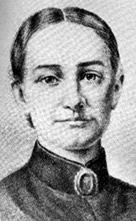Marcus Whitman sought to ‘save’ Oregon, but not from Brits
Persistent legend claims the pioneer doctor and preacher, before he was killed in the 'Whitman Massacre,' foiled Britain's plans to take over by recruiting the first wave of Oregon Trail emigrants — but it's probably bunk. Here's why.
EDITOR'S NOTE: A revised, updated and expanded version of this story was published in 2024 and is recommended in preference to this older one. To read it, click here.
This bronze statue of Marcus Whitman, clad in a pioneer's buckskins
and carrying a Bible under his arm, stands in the foyer of Washington's
state capitol in Olympia.
(Image courtesy state of Washington)
By Finn J.D. John — October 4, 2010
Downloadable audio file (MP3)
Just about everybody remembers, from third-grade civics class, the story of Paul Revere’s midnight ride. And most people have since learned that his ride was a bit less dramatic than was portrayed in the famous poem about it.
Oregon has a similar legend from its early days in the stretched story of how Marcus Whitman “saved Oregon.”
The Whitman Massacre
Marcus Whitman was a missionary who, with his equally famous wife, Narcissa, established four outposts in the Oregon country in 1836, before it was even officially a territory, for purposes of ministering to Native Americans there. This went pretty well until a Caucasian guest at the mission came down with German Measles, and the illness got transmitted somehow to the Indians. It was devastating for them, killing roughly nine out of every 10. Shocked and horrified, the surviving Natives — those not yet touched by the disease — rose up and wiped out the Whitman Mission at Walla Walla in 1847, killing the Whitmans and everyone else. In the process, of course, they probably exposed themselves to the measles, which is more than anything else responsible for how “peacefully” Oregon was settled by emigrants.
The Marcus Whitman legend: Foiling the E.P.B. (Evil Plotting British)
The artifacts in this photo came from the scene of the Whitman killings in
1847 by members of the Cayuse Tribe. A number of tribe members were
later arrested, charged and eventually hanged for their alleged
participation in what became known as the "Whitman Massacre."
This
photo, on a glass negative, probably dates from sometime in the first
two decades
of the 20th century.
(Image courtesy University of Oregon
Libraries)
But, the legend: According to this tall tale, Whitman realized in 1842 that the British were about to make a play for full ownership of the Oregon country, which had been held under joint occupancy treaties dating back to the War of 1812. The crux of the problem was population: There were more Brits in the area than Americans.
What was needed, the Whitman of the legend presciently knew, was a giant torrent of covered wagons crossing the continent and packing the state with American settlers, who could then turn the tables on those wicked, plotting British.
So in the dead of winter, the legend continues, Whitman set out to traverse what would soon become known as the Oregon Trail, racing to alert President Tyler that the Oregon country was about to be lost to Britain unless he could get a bunch of Americans on the road west. Despite the well-intentioned obstructionism of Daniel Webster, Tyler leaped to his feet, seized the Presidential bugle and blew a stirring call to arms; Whitman set about in a patriotic frenzy of pamphleteering and public speaking to assemble a mighty armada of prairie schooners stuffed with American settlers; and next thing you knew, Whitman was returning in triumph at the head of this massive covered-wagon armada, leading thousands of rugged American pioneers to Oregon like a new Moses and foiling the machinations of the British pharaohs.
And that’s how Marcus Whitman saved Oregon. Or so the story goes.
The truth of the matter
Marcus Whitman
Turns out that story was purely made in Oregon, probably as the fruit of a coincidence and some fanciful guesswork.
Narcissa Whitman
Whitman did in fact go back east in the dead of winter, but it was to argue against a plan to close three of his four Northwest mission stations, not to urge Americanization of Oregon. So far as I’ve been able to document, he never met with the president and made no organized effort to inspire emigrants — although he was enthusiastically supportive of them and of the settlement process.
How the myth arose
But it’s easy to see how the myth took hold. After all, it’s quite true that the British were hoping to take over. It’s also true that the very spring after Whitman’s dramatic wintertime voyage, the first big wave of covered wagons started over the continent on the Oregon Trail — what had been a trickle became a torrent of American settlers, who quickly made any British claim on Oregon impossible to pursue.
Moreover, Whitman really did return with a massive party of covered wagons. He was a trained physician, so his services were in demand — and after all, why would anyone travel across the Oregon Trail alone if he could help it? So for the beleaguered Americans in the Oregon country, it must have looked, in retrospect at least, a lot like a case of Whitman bringing the cavalry.
This drawing from Marcus Whitman M.D.: Pioneer and Martyr, by Clifford Merrill
Drury (1937),
shows what the artist imagined the slaying of Whitman looked like. As is
readily apparent, there are some factual inconsistencies. (Image courtesy state of Oregon)
When, shortly after his return, Whitman died in the “Whitman Massacre,” it was easy to interpret that as influenced by British vengefulness; the British, as traders rather than settlers, had much better relations with Indians than Americans did.
A more cynical theory
Stewart Holbrook suggests that the myth of Whitman’s salvation of Oregon was crafted by other members of his mission outposts, in an effort to get a cash indemnity from the federal government. This scenario seems unlikely; after all, the legend tells of Whitman doing a lot of lobbying in Washington and other areas of the east. No sensible person would try to sell a phony story to people who can fact-check it by simply asking neighbors about it. It’s far more likely that the other missionaries had nothing to do with making the myth and simply used it, believing it to be true, to bolster their case.
Marcus Whitman, a man of God who died in an effort to share his faith with others, might not have appreciated having his legend repurposed from Christian martyr to American patriot. But in the light of history, that’s pretty much what happened.
(Sources: Nixon, Oliver W. How Marcus Whitman Saved Oregon. Chicago: Star Publishing, 1895; Holbrook, Stewart. The Far Corner. Sausalito, Calif.: Comstock, 1973; Gulick, Bill. Roadside History of Oregon. Missoula, Mont.: Mountain Press, 1991.)
TAGS: #MissionaryWork #WhitmanMassacre #MarcusWhitman #Narcissa #GermanMeasles #Pandemic #JointOccupancy #5440orFight #WarOf1812 #OregonTrail #Emigrants #CoveredWagons #OliverNixon #StewartHolbrook #BillGulick
















